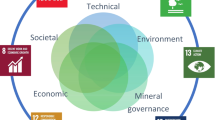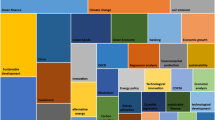Abstract
Cost–benefit analysis was applied for 120 MW Samanalawewa hydroelectric reservoir plant in Sri Lanka. Valuation methods were applied to estimate losses in agriculture, natural vegetation, water losses and benefits of avoided carbon emissions. The project resulted in a negative net present value under the standard conditions stipulated and possible changes to the variables to make the project positive were investigated. The study highlights the importance of valuing environmental and social impacts where large-scale transformation of land uses in sensitive areas is involved. It outlines a framework for a composite tool that could accommodate environmental externalities, social inequities and uncertainties along expanded temporal and spatial scales.
Similar content being viewed by others
References
Acreman M, Dunbar MJ (2004) Defining environmental river flow requirements? A review. Hydrol Earth Syst Sci Discuss 8(5):861–876
Adger WN, Brown K (1994) Land use and the causes of global warming. John Wiley, Hoboken
Brismar A (2004) Attention to impact pathways in EISs of large dam projects. Environ Impact Assess Rev 24(1):59–87
Bugaje I (2006) Renewable energy for sustainable development in Africa: a review. Renew Sustain Energy Rev 10(6):603–612
Bundestag G (ed) (1990) Protecting the tropical forests: a high priority international task. Bonner Universitats-Buchdruckerei, Bonn
CEB (1996) Samanalawewa hydroelectric project completion report. Nippon Koei Co. Ltd., Electrowatt Engineering Services Ltd, Tokyo
CEB (2006) Long-term generation expansion planning studies 2006–2015. Transmission and Generation Planning Branch, Ceylon Electricity Board (CEB), Colombo
CEB (2015) Long-term generation expansion plan 2015–2034. Transmission and Generation Planning Branch, Ceylon Electricity Board (CEB), Colombo
de Almeida AT, Moura PS, Marques AS, de Almeida JL (2005) Multi-impact evaluation of new medium and large hydropower plants in Portugal centre region. Renew Sustain Energy Rev 9(2):149–167
EPA (2016) The social cost of carbon estimating the benefits of reducing greenhouse gas emissions. https://19january2017snapshot.epa.gov/climatechange/social-cost-carbon_.html Accessed 15 Apr 2018
FAO (1997) Energy and environment basics. FAO Regional Wood Energy Development Programme in Asia, Bangkok
Fernando S (2002) Meeting Sri Lanka’s future electricity needs. Energy Sustain Dev 6(1):14–20
Frey GW, Linke DM (2002) Hydropower as a renewable and sustainable energy resource meeting global energy challenges in a reasonable way. Energy Policy 30(14):1261–1265
Fujikura R, Nakayama M, Takesada N (2009) Lessons from resettlement caused by large dam projects: case studies from Japan, Indonesia and Sri Lanka. Water Resour Dev 25(3):407–418
Gagnon L, van de Vate JF (1997) Greenhouse gas emissions from hydropower: the state of research in 1996. Energy Policy 25(1):7–13
Gunawardena UADP (2010) Inequalities and externalities of power sector: a case of broadlands hydropower project in Sri Lanka. Energy Policy 38(2):726–734
Gunawardena UADP (2013) An inquiry into ethical foundations of cost benefit analysis. J Environ Prof Sri Lanka 1(2):1–15
Hanley N, Craig S (1991) Wilderness development decisions and the Krutilla–Fisher model: the case of Scotland’s ‘flow country’. Ecol Econ 4(2):145–164
Hanley N, Spash CL (1993) Cost-benefit analysis and the environment. Edward Elgar Aldershot, Cheltenham
Head CR (2000) Financing of private hydropower projects, vol 420. World Bank Publications, Washington, DC
Houghton R, Boone R, Fruci J, Hobbie J, Melillo J, Palm C, Peterson B, Shaver G, Woodwell G, Moore B (1987) The flux of carbon from terrestrial ecosystems to the atmosphere in 1980 due to changes in land use: geographic distribution of the global flux. Tellus B 39(1–2):122–139
IHA (2015) Hydropower status report. Int Hydropower Assoc Ltd, United Kingdom
Kibler KM, Tullos DD (2013) Cumulative biophysical impact of small and large hydropower development in Nu River, China. Water Resour Res 49(6):3104–3118
Kotchen MJ, Moore MR, Lupi F, Rutherford ES (2006) Environmental constraints on hydropower: an ex post benefit-cost analysis of dam relicensing in Michigan. Land Econ 82(3):384–403
Krutilla JV, Fisher AC (1985) The economics of natural environments: studies in the valuation of commodity and amenity resources. Resources for the Future, Washington, DC
Kucukali S (2011) Risk assessment of river-type hydropower plants using fuzzy logic approach. Energy Policy 39(10):6683–6688
Lakshman (2007). http://www2.jica.go.jp/ja/evaluation/pdf/2006_SL-P11_4_t.pdf. http://www2.jica.go.jp/ja/evaluation/pdf/2006_SL-P11_4_t.pdf. Accessed 15 Nov 2017
Laksiri K, Gunathilake J, Iwao Y (2005) A case study of the samanalawewa reservoir on the Walawe River in an area of Karst in Sri Lanka In: Proceedings of the 10th multidisciplinary conference on sinkholes and the engineering and environmental impacts of karst, held in San Antonio, Texas, September 2005, p 24–28
Manatunge J, Takesada N (2013) Long-term perceptions of project-affected persons: a case study of the Kotmale Dam in Sri Lanka. Int J Water Resour Dev 29(1):87–100
Manatunge J, Takesada N, Miyata S, Herath L (2009) Livelihood rebuilding of dam-affected communities: case studies from Sri Lanka and Indonesia. Water Resour Dev 25(3):479–489
Martinot E (2001) Renewable energy investment by the World Bank. Energy Policy 29(9):689–699
McCartney M, Sullivan C, Acreman MC, McAllister D (2000) Ecosystem impacts of large dams. Thematic Rev II 1:1
Mei X, Van Gelder P, Dai Z, Tang Z (2017) Impact of dams on flood occurrence of selected rivers in the United States. Front Earth Sci 11(2):268–282
Nandalal K, Sakthivadivel R (2002) Planning and management of a complex water resource system: case of Samanalawewa and Udawalawe reservoirs in the Walawe river, Sri Lanka. Agric Water Manag 57(3):207–221
Pearce DW, Turner RK (1990) Economics of natural resources and the environment. JHU Press, Baltimore
Pearce DW, Markandya A, Barbier E (1989) Blueprint for a green economy, vol 1. Earthscan, Abingdon
Sachdev HS, Akella AK, Kumar N (2015) Analysis and evaluation of small hydropower plants: a bibliographical survey. Renew Sustain Energy Rev 51:1013–1022
Sample JE, Duncan N, Ferguson M, Cooksley S (2015) Scotland’s hydropower: current capacity, future potential and the possible impacts of climate change. Renew Sustain Energy Rev 52:111–122
Siciliano G, Urban F, Kim S, Lonn PD (2015) Hydropower, social priorities and the rural–urban development divide: the case of large dams in Cambodia. Energy Policy 86:273–285
TEAMS (1992a) Samanalawewa Hydro Electric Project, Environmental Post Evaluation Study-(Draft final report). TEAMS (Pvt). Ltd, Colombo
TEAMS (1992b) Samanalawewa hydro electric project, environmental post evaluation study (interim report), vol 15. TEAMS (Pvt). Ltd, Colombo
TEAMS (1992c) Samanalawewa hydro electric project, environmental post evaluation study (draft final report), vol 250. TEAMS (Pvt). Ltd, Colombo
Udayakumara EPN, Shrestha RP (2011) Assessing livelihood for improvement: Samanalawewa reservoir environs, Sri Lanka. Int J Sustain Dev World Ecol 18(4):366–376
Udayakumara EPN, Wijeratne AW (2004) Estimation of economic loss due to reduction of paddy land areas: construction of Samanalawewa Reservoir. In: Proceedings of Water Professionals’ Day 2004. Geo Informatics Society of Sri Lanka (GISSL), Sri Lanka
Udayakumara EPN, Shrestha RP, Samarakoon L, Schmidt-Vogt D (2010) People’s perception and socioeconomic determinants of soil erosion: a case study of Samanalawewa watershed, Sri Lanka. Int J Sedim Res 25(4):323–339
Udayakumara EPN, Shrestha RP, Samarakoon L, Schmidt-Vogt D (2012) Mitigating soil erosion through farm-level adoption of soil and water conservation measures in Samanalawewa Watershed, Sri Lanka. Acta Agric Scand Sect B Soil Plant Sci 62(3):273–285
WCD (2000) Dams and development: a new framework for decision-making. Earthscan Publication Ltd, London
Winter H, Jansen H, Bruijs M (2006) Assessing the impact of hydropower and fisheries on downstream migrating silver eel, Anguilla anguilla, by telemetry in the River Meuse. Ecol Freshw Fish 15(2):221–228
Zhang J, Xu L, Li X (2015) Review on the externalities of hydropower: a comparison between large and small hydropower projects in Tibet based on the CO2 equivalent. Renew Sustain Energy Rev 50:176–185
Zubair L (2001) Challenges for environmental impact assessment in Sri Lanka. Environ Impact Assess Rev 21(5):469–478
Author information
Authors and Affiliations
Corresponding author
Rights and permissions
About this article
Cite this article
Udayakumara, E.P.N., Gunawardena, U.A.D.P. Cost–Benefit Analysis of Samanalawewa Hydroelectric Project in Sri Lanka: An Ex Post Analysis. Earth Syst Environ 2, 401–412 (2018). https://doi.org/10.1007/s41748-018-0060-z
Received:
Revised:
Accepted:
Published:
Issue Date:
DOI: https://doi.org/10.1007/s41748-018-0060-z








